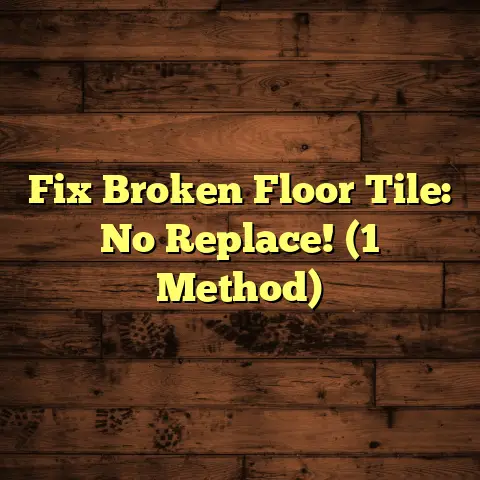DIY Wood Floor Cleaner Recipe? (3 Damage Risks!)
I’m seeing a huge trend in energy-efficient homes, and it’s awesome.
It’s all about creating a comfy, healthy space while saving some green.
One thing I’ve noticed is how many of you are looking for sustainable ways to clean, too.
DIY cleaning solutions are popping up everywhere, and for good reason. They can save you money, reduce waste, and be better for your health.
Think about it: less packaging, fewer chemicals, and a smaller carbon footprint.
But let’s talk about those gorgeous wood floors.
Keeping them clean is key, but you’ve got to be careful. That’s where the right cleaning methods come in, especially when going DIY.
In this article, I’m diving deep into a DIY wood floor cleaner recipe. I’ll share the benefits, but also give you the straight scoop on three potential risks.
Ready to get started? Let’s do this!
Understanding Wood Floors
Okay, first things first: not all wood floors are created equal. I’ve worked with tons of different types over the years, and each one has its own personality, especially when it comes to cleaning.
Here’s a quick rundown:
-
Solid Hardwood: This is the real deal – planks made from a single piece of wood. It’s beautiful, durable, and can be refinished multiple times.
-
Engineered Wood: This is made of layers of plywood with a hardwood veneer on top. It’s more stable than solid hardwood, especially in areas with high humidity.
-
Laminate: This isn’t actually wood at all! It’s a synthetic material that looks like wood. It’s budget-friendly and scratch-resistant, but it can’t be refinished.
Each type reacts differently to cleaning products. Solid hardwood, for example, can handle certain cleaners that might damage laminate. Engineered wood is somewhere in between.
Why Choosing the Right Cleaner Matters
Think of your wood floor’s finish as a protective shield. It’s what keeps moisture, dirt, and grime from penetrating the wood itself.
Using the wrong cleaner can weaken or even destroy that shield, leading to:
- Dulling
- Scratches
- Water damage
- Discoloration
I’ve seen it all, trust me. I always tell my clients that the right cleaner will prolong the life of their floors and keep them looking their best.
The Enemy: Common Contaminants
Let’s face it: floors get dirty. It’s just a fact of life. But knowing what you’re up against can help you choose the right cleaning strategy.
Here are some common culprits:
-
Dirt and Grime: Tracked in from outside, this is the everyday stuff that dulls your floors.
-
Pet Dander: If you have furry friends, you know the struggle. Pet dander can build up and create a sticky film.
-
Moisture: Spills, leaks, and even humidity can damage wood floors over time.
-
Food Splatters: We’ve all been there. Sticky messes can be tough to remove.
Regular cleaning is key to keeping these contaminants at bay. I recommend sweeping or vacuuming at least once a week, and mopping every couple of weeks.
Benefits of DIY Cleaning Solutions
Now, let’s talk about why so many people are making their own cleaning solutions. I get it! There are some serious perks:
-
Cost-Effectiveness: Store-bought cleaners can be expensive. DIY solutions use ingredients you probably already have on hand, like vinegar and water.
- Example: A gallon of commercial wood floor cleaner can cost $15-$30. A DIY solution using vinegar and water might cost less than $1 per gallon.
-
Eco-Friendliness: Commercial cleaners often come in plastic bottles and contain harsh chemicals that can harm the environment.
- Statistic: According to the EPA, over 25 million tons of plastic waste was generated from containers and packaging in 2018.
DIY cleaners let you reuse bottles and reduce your exposure to harmful substances.
-
Safety: Many commercial cleaners contain ingredients that can irritate your skin, eyes, and lungs. DIY solutions let you control what goes into your cleaner, making it safer for your family and pets.
-
Customization: This is a big one! You can tweak DIY recipes to suit your specific flooring type and preferences.
- Example: If you have sensitive skin, you can avoid using essential oils that might cause irritation.
-
Healthier Home Environment: By reducing your exposure to harsh chemicals, you’re creating a healthier living space for everyone.
- Study: A study published in Environmental Health Perspectives found that exposure to certain cleaning products was associated with respiratory problems.
I’ve found that DIY cleaners are a great way to save money, protect the environment, and create a healthier home.
The DIY Wood Floor Cleaner Recipe
Alright, let’s get to the good stuff! Here’s a simple and effective DIY wood floor cleaner recipe that I’ve used for years:
Ingredients:
- 1/2 cup white vinegar
- 1 gallon warm water
- Optional: 5-10 drops of your favorite essential oil (lemon, lavender, or tea tree are good choices)
Equipment:
- Bucket
- Spray bottle (optional)
- Microfiber mop or cloth
Instructions:
-
Mix the ingredients: In a bucket, combine the warm water and vinegar. Add essential oils if desired.
- Tip: Use distilled water for best results, especially if you have hard water.
-
Prepare your mop: Dampen your microfiber mop or cloth with the cleaning solution. Make sure it’s damp, not soaking wet.
-
Clean the floor: Mop the floor in sections, rinsing the mop or cloth as needed.
-
Dry the floor: Use a clean, dry microfiber cloth to dry any excess moisture.
- Tip: Open windows or use a fan to speed up the drying process.
Application Tips:
-
Sweep or vacuum first: Always remove loose dirt and debris before mopping.
-
Don’t over-wet: A damp mop is all you need. Too much water can damage wood floors.
-
Work in sections: This helps prevent the cleaning solution from drying before you can wipe it up.
-
Rinse your mop frequently: This will prevent you from spreading dirt around.
-
Test in an inconspicuous area: Before cleaning your entire floor, test the solution in a small, hidden area to make sure it doesn’t damage the finish.
I’ve found this recipe to be super effective and easy to use. Give it a try and see what you think!
Three Damage Risks of DIY Wood Floor Cleaners
Okay, here’s where I put on my “expert” hat and give you the real deal. While DIY cleaners can be great, they’re not without their risks. I’ve seen these mistakes happen, and I want to help you avoid them.
Risk 1: Improper Ingredients
This is probably the biggest mistake I see. People assume that all natural ingredients are safe for wood floors, but that’s just not true.
The Vinegar Problem:
Vinegar is a popular ingredient in DIY cleaners because it’s cheap, readily available, and effective at cutting through grease and grime. However, it’s also acidic.
-
The Danger: Over time, vinegar can dull or even damage the finish on certain wood floors, especially those with a polyurethane coating.
- Explanation: The acid in vinegar can break down the protective layer, leaving your floors vulnerable to scratches and water damage.
-
What to Do: If you’re going to use vinegar, dilute it properly (no more than 1/2 cup per gallon of water) and don’t use it every time you clean.
- Alternative: Consider using a pH-neutral cleaner instead.
Other Ingredients to Avoid:
-
Lemon Juice: Similar to vinegar, lemon juice is acidic and can damage wood finishes.
-
Baking Soda: While it’s a great abrasive cleaner, baking soda can scratch wood floors.
-
Ammonia: This is a harsh chemical that can strip the finish off your floors.
Risk 2: Over-Wetting
Water is the enemy of wood floors. I can’t stress this enough! Excessive moisture can cause:
- Warping
- Buckling
- Cupping
- Discoloration
I’ve seen floors that have been completely ruined by water damage. It’s not pretty, and it’s expensive to fix.
-
The Problem: When you mop, water can seep into the seams between the boards and get trapped underneath the floor. This can lead to mold growth and structural damage.
-
What to Do:
-
Use a damp mop, not a wet mop: Wring out your mop thoroughly before cleaning. It should be damp to the touch, not dripping.
-
Clean up spills immediately: Don’t let water sit on your floor. Wipe it up right away.
-
Avoid steam mops: Steam mops use hot water to clean, which can be disastrous for wood floors.
-
Ensure Proper Ventilation: Open windows or use fans to dry the floor quickly after cleaning.
-
Risk 3: Allergic Reactions and Residue
Even natural ingredients can cause problems. I’ve seen people have allergic reactions to essential oils, and I’ve also seen DIY cleaners leave behind a sticky residue.
-
Allergic Reactions:
-
The Problem: Essential oils are highly concentrated and can cause skin irritation, respiratory problems, and other allergic reactions in sensitive individuals.
-
What to Do:
-
Test essential oils: Before using an essential oil in your cleaner, test it on a small area of your skin to make sure you don’t have a reaction.
-
Use essential oils sparingly: A few drops is all you need.
-
Avoid common allergens: Some essential oils, like lavender and tea tree, are more likely to cause allergic reactions than others.
-
-
-
Residue:
-
The Problem: Some DIY cleaners can leave behind a sticky or dulling residue that attracts dirt and makes your floors look even worse.
- Example: Using too much soap or oil in your cleaner can cause residue buildup.
-
What to Do:
-
Use the right ratios: Follow the recipe carefully and don’t add extra ingredients.
-
Rinse with clean water: After mopping with your DIY cleaner, rinse the floor with clean water to remove any residue.
-
Use a microfiber mop: Microfiber mops are great at picking up dirt and residue.
-
-
Safe Practices for Using DIY Cleaners
Okay, I’ve scared you enough, right? Don’t worry, DIY cleaning can be done safely! Here are some tips to help you avoid the pitfalls I’ve described:
-
Test, Test, Test: I can’t say this enough. Before cleaning your entire floor, test your DIY cleaner in a small, inconspicuous area.
-
Where to Test: Try testing under a rug or in a closet.
-
What to Look For: Check for any discoloration, dulling, or damage to the finish.
-
-
Follow Dilution Ratios: Don’t eyeball it! Use measuring cups and spoons to ensure you’re using the right amount of each ingredient.
-
Choose the Right Tools:
-
Microfiber Mops: These are the best choice for wood floors. They’re gentle, absorbent, and effective at picking up dirt and residue.
-
Soft Cloths: Use soft, lint-free cloths for drying and buffing your floors.
-
Avoid Abrasive Scrubbers: These can scratch your floors.
-
-
Regular Maintenance: Prevent the accumulation of dirt and grime by sweeping or vacuuming regularly.
- Frequency: Aim to sweep or vacuum at least once a week, or more often if you have pets or kids.
-
Address Spills Immediately: Don’t let spills sit on your floor. Wipe them up right away with a clean, dry cloth.
-
Consider Your Floor’s Finish: If you’re not sure what type of finish you have, consult a flooring professional.
- Why This Matters: Different finishes require different cleaning methods.
Conclusion
Alright, we’ve covered a lot! Let’s recap:
DIY wood floor cleaners can be a fantastic way to save money, reduce your environmental impact, and create a healthier home.
But, you’ve got to be careful. Using the wrong ingredients, over-wetting your floors, or ignoring potential allergic reactions can lead to serious damage.
Remember:
- Choose your ingredients wisely.
- Use a damp mop, not a wet mop.
- Test your cleaner in an inconspicuous area first.
- Sweep or vacuum regularly.
- Address spills immediately.
By following these tips, you can keep your wood floors looking beautiful for years to come.
I encourage you to think about your cleaning habits and the impact they have on your home environment. Are you using sustainable practices? Are you protecting your floors?
Every little bit helps, and by making informed choices, we can all create healthier, more energy-efficient homes.
Now, go forth and clean responsibly!





